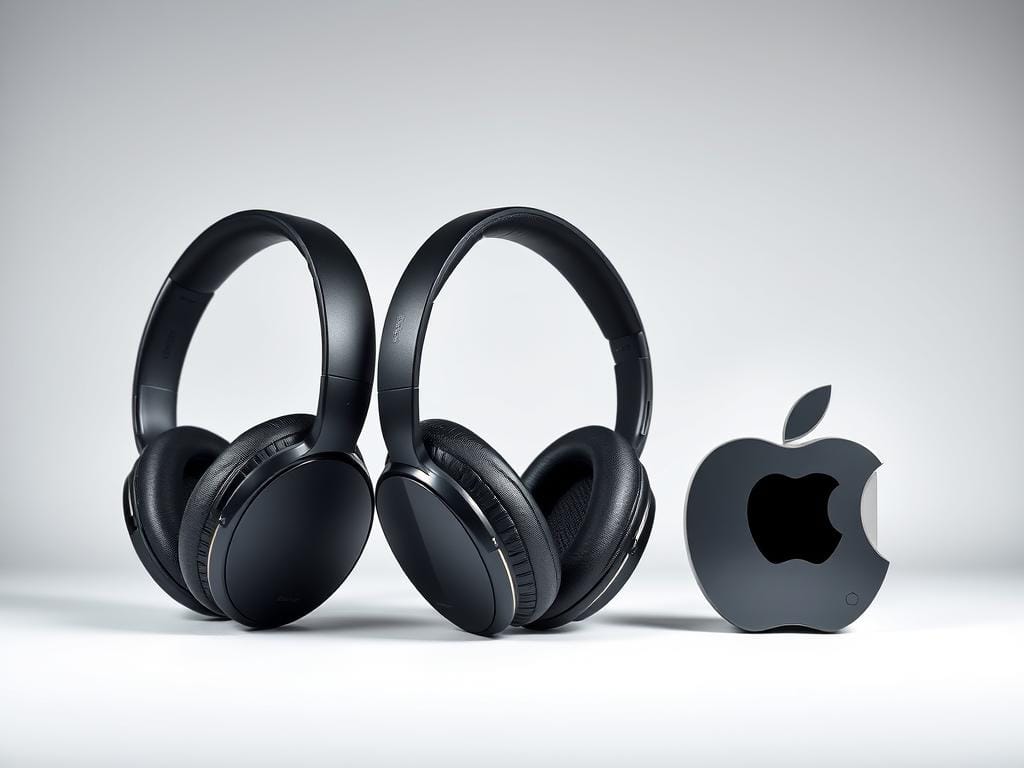The demand for noise-canceling headphones has skyrocketed as people seek refuge from the constant din of modern life. With top brands like Sony, Bose, and Apple vying for dominance, choosing the right pair can be daunting.
We’re comparing the flagship models – Sony WH-1000XM5, Bose QuietComfort Ultra Headphones, and Apple AirPods Max – to help you make an informed decision. These premium headphones offer advanced noise cancellation and superior sound quality, but come with a hefty price tag.
Our review will pit these top contenders against each other, evaluating their features, price, and overall performance to determine which pair is the best choice for your needs.
Key Takeaways
- Comparison of top noise-canceling headphones from Sony, Bose, and Apple.
- Evaluation of noise cancellation, sound quality, and features.
- Analysis of price and overall value.
- Guidance on choosing the best headphones for your specific needs.
- Insights into the latest advancements in wireless headphone technology.
The Premium Noise-Canceling Headphone Market in 2025
As we dive into 2025, the premium noise-canceling headphone landscape is marked by innovation and high-end features. The market is dominated by three major players: Sony, Bose, and Apple, each bringing unique strengths to their flagship models.
Let’s take a closer look at the standout products from these leading brands.
Sony WH-1000XM5
The Sony WH-1000XM5, priced at $399.99, represents the fifth generation of Sony’s acclaimed 1000X series. It builds on a legacy of excellent noise cancellation and audio quality while introducing refined design elements and improved voice call performance.
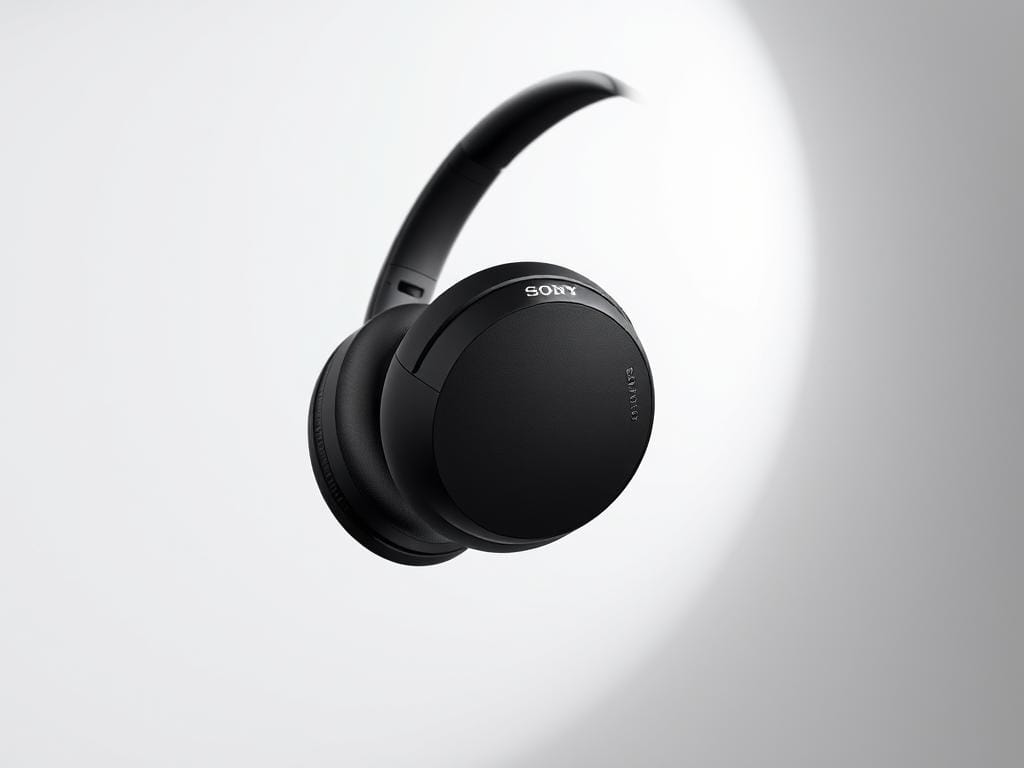
Bose QuietComfort Ultra Headphones
Bose’s QuietComfort Ultra Headphones are available for $429, offering industry-leading noise cancellation technology and immersive audio features. They maintain the brand’s reputation for exceptional comfort during extended listening sessions.
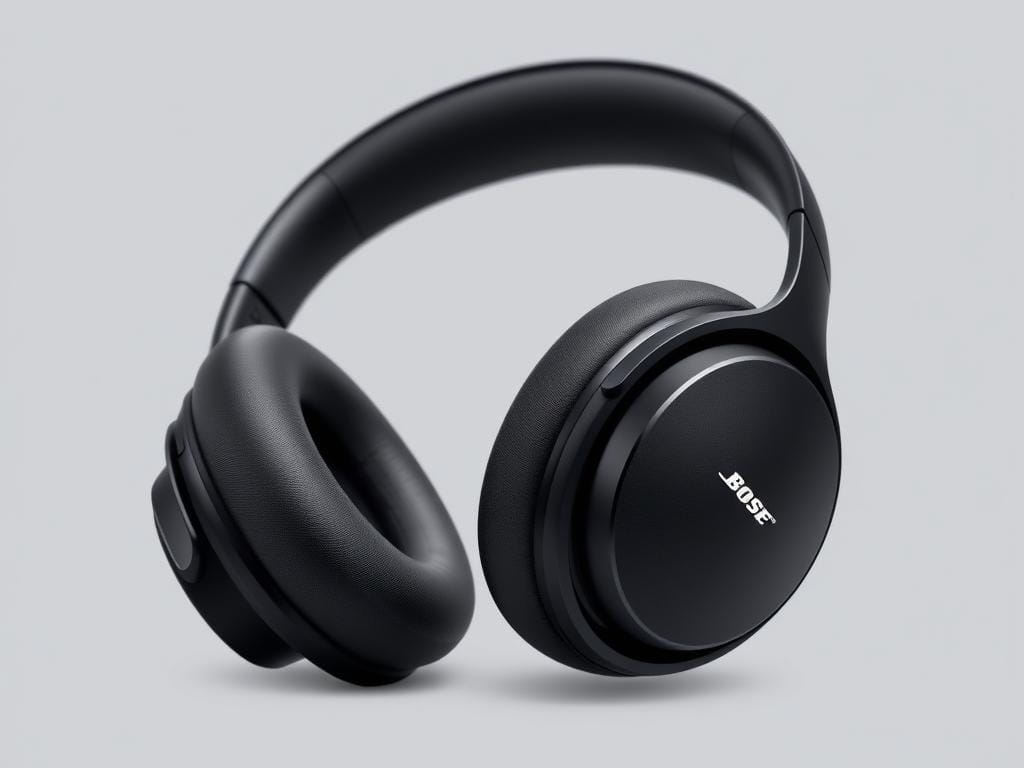
Apple AirPods Max
Apple AirPods Max, priced at $549, stand as the premium option in this comparison. They offer seamless integration with Apple’s ecosystem, distinctive aluminum design, and computational audio features that enhance the listening experience for Apple device users.

The price differential between these models, with a $150 gap between Sony and Apple, raises important questions about value and whether the additional features justify the higher investment for certain users.
Active Noise Cancellation Performance
ANC performance varies significantly across the latest flagship headphones from Sony, Bose, and Apple. We will delve into the specifics of how these brands implement Active Noise Cancellation, a critical feature for immersive listening.
Low-Frequency Noise Reduction
The Bose QuietComfort Ultra Headphones stand out in their ability to reduce low-frequency noise, such as the rumble of airplane engines or subway noise. While the Sony WH-1000XM5 and Apple AirPods Max follow closely, Bose’s implementation is notably effective in this range.
Mid-Range Frequency Handling
When it comes to handling mid-range frequencies, such as human voices and ambient cafe chatter, Bose again leads the pack. Their ability to cut through complex midrange noises makes them particularly suitable for office environments or busy spaces.
Adaptive ANC Technology
All three models feature adaptive ANC technology, adjusting to environmental changes and head movements. However, Bose’s implementation can sometimes result in noticeable pressure changes, a trait less pronounced in Sony’s WH-1000XM5, which offers a more comfortable experience with less pressure sensation.
| Headphones | Low-Frequency Noise Reduction | Mid-Range Frequency Handling | Adaptive ANC Technology |
|---|---|---|---|
| Sony WH-1000XM5 | Excellent | Very Good | Excellent, with minimal pressure sensation |
| Bose QuietComfort Ultra | Outstanding | Excellent | Very Effective, but with noticeable pressure changes |
| Apple AirPods Max | Very Good | Good | Effective, with some pressure sensation |
In conclusion, while all three headphones offer impressive ANC performance, their effectiveness varies across different frequency ranges and environments. The Bose QuietComfort Ultra Headphones excel in low-frequency noise reduction and mid-range handling, making them a top choice for noisy environments. Meanwhile, the Sony WH-1000XM5 offers a more comfortable ANC experience with less pressure sensation, ideal for long listening sessions.
Sound Quality and Audio Performance

Sound quality is the defining characteristic of premium headphones, and the latest offerings from Sony, Bose, and Apple are redefining the listening experience. Each of these brands brings its unique approach to audio performance, leveraging advanced driver technologies and sound signatures to captivate listeners.
Driver Technology and Sound Signature
The driver technology in these headphones varies significantly, influencing their sound signature. The Apple AirPods Max boasts 40mm dynamic drivers, delivering a crisp and bass-rich experience without embellishing deep bass unnecessarily. In contrast, the Bose QuietComfort Ultra features 35mm drivers that produce a deep, clear low-end, making them a hit among bass enthusiasts. Meanwhile, Sony’s WH-1000XM5 utilizes 30mm drivers optimized for clarity across frequencies, offering a balanced sound.
Bass Response and Clarity
Bass response is a critical aspect of audio performance, and these headphones handle it differently. Sony’s WH-1000XM5 offers pronounced but controlled bass, while Bose QuietComfort Ultra delivers deep, powerful low-end that remains clear and flub-free. Apple AirPods Max, on the other hand, provides accurate bass reproduction that stays faithful to the original recording, avoiding unnecessary embellishments.
Spatial Audio Capabilities
Spatial audio has become a key feature in premium headphones, enhancing the immersive listening experience. Apple leads with its implementation of dynamic head tracking and Dolby Atmos support, creating a convincing soundstage. Bose offers immersive audio that simulates a live environment, while Sony’s 360 Reality Audio provides spatial awareness, though with less convincing head tracking compared to Apple.
As we explore these headphones, it’s clear that each brand has its strengths in sound quality and audio performance. Whether it’s the precise bass response of Apple AirPods Max, the immersive spatial audio of Bose QuietComfort Ultra, or the balanced sound signature of Sony WH-1000XM5, there’s a winner in this competition based on individual preferences.
Sony vs Bose vs Apple headphones: Design and Comfort
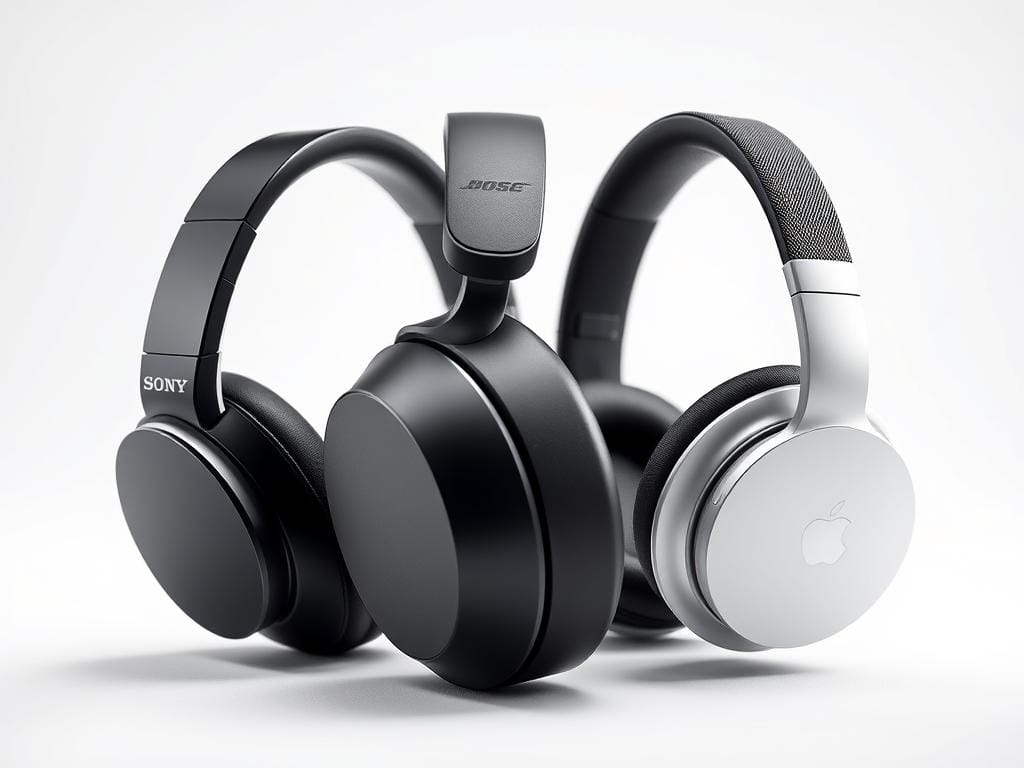
In the realm of high-end headphones, Sony, Bose, and Apple have taken distinctly different approaches to design and comfort. When evaluating these premium products, it becomes clear that each brand prioritizes different aspects to cater to various user preferences.
Materials and Build Quality
The Apple AirPods Max feature premium aluminum cups and a mesh headband, creating a luxury feel. In contrast, the Bose QuietComfort Ultra utilizes high-grade plastics and plush padding, optimized for comfort. Meanwhile, the Sony WH-1000XM5 employs lightweight materials with a focus on minimalist design.
| Headphones Model | Materials | Build Quality |
|---|---|---|
| Apple AirPods Max | Premium Aluminum, Mesh | Luxury Feel |
| Bose QuietComfort Ultra | High-grade Plastics, Plush Padding | Comfort-Oriented |
| Sony WH-1000XM5 | Lightweight Materials | Minimalist Design |
Weight and Pressure Distribution
The Bose QuietComfort Ultra stands out for its exceptionally plush and lightweight design, ensuring comfort over extended listening sessions. In contrast, the AirPods Max feel heavier and exert more pressure on the head.
Color Options and Aesthetics
Apple AirPods Max lead in terms of color variety, offering five distinctive options: green, pink, silver, sky blue, and space gray. While Bose and Sony offer more conservative color palettes, their design sensibilities remain appealing.
The differences in design philosophy reflect each brand’s priorities: Apple emphasizes premium materials, Bose focuses on comfort, and Sony balances aesthetics with practicality.
Battery Life and Charging
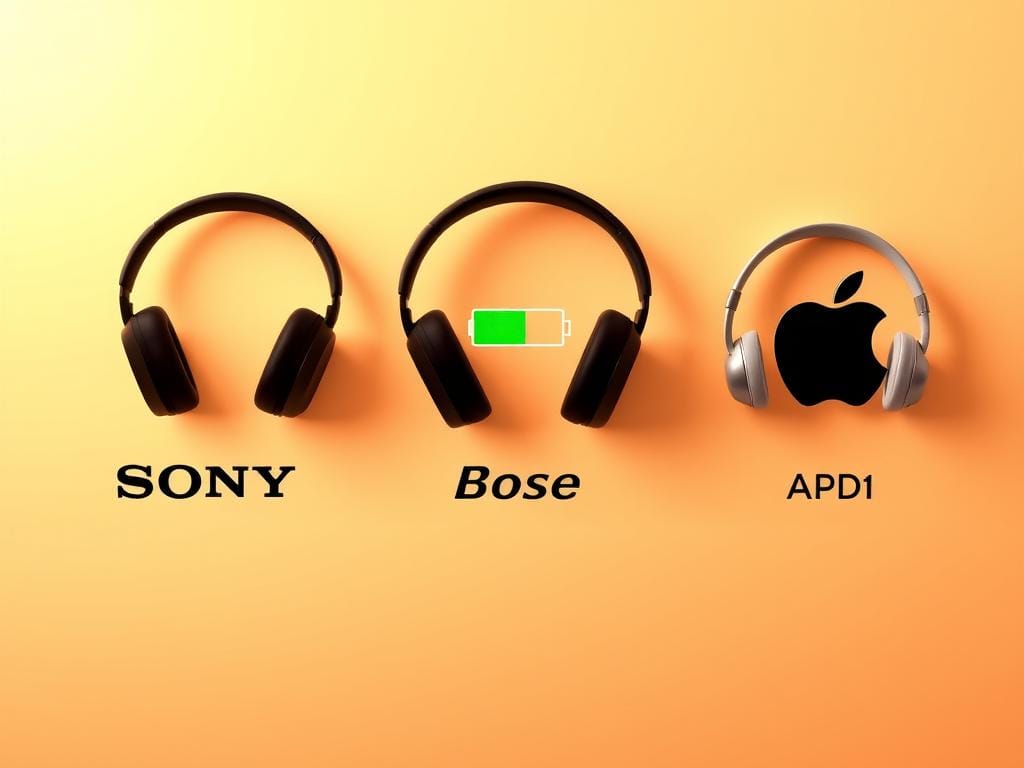
Battery life remains a top priority for those investing in premium wireless headphones. We examine the runtime, charging capabilities, and power management features of the Sony WH-1000XM5, Bose QuietComfort Ultra Headphones, and Apple AirPods Max.
Runtime with ANC Enabled
The runtime with Active Noise Cancellation (ANC) enabled varies across these premium models. Sony’s WH-1000XM5 offers up to 24 hours of playback with ANC on, while Bose’s QuietComfort Ultra Headphones provide approximately 24 hours (dropping to 18 hours with immersive audio). Apple AirPods Max deliver around 20 hours of continuous use with ANC enabled.
Charging Speed and Options
Charging speed and options differ significantly among these models. Apple AirPods Max offer quick charging, providing 1.5 hours of playback from just 5 minutes of charging. In contrast, Bose QuietComfort Ultra Headphones require about 3 hours for a full charge, while Sony WH-1000XM5 needs approximately 3.5 hours to reach full capacity.
Power Management Features
Each brand has implemented unique power management features. Apple’s Smart Case puts AirPods Max into an ultra-low-power sleep mode, preserving battery life. Sony’s adaptive power management optimizes battery usage based on activity, while Bose maintains consistent performance throughout the battery life cycle.
- Battery life is a critical consideration for wireless headphones, with significant variations in runtime and charging capabilities.
- Real-world battery life can vary based on listening volume, codec selection, and feature usage.
- Power management features play a crucial role in optimizing battery life across these premium models.
Connectivity and Compatibility
Connectivity and compatibility are key considerations when selecting the ideal noise-canceling headphones for your needs. The way these features are implemented can significantly impact your overall listening experience, whether you’re using them with a smartphone, laptop, or other devices.
Bluetooth Codecs and Versions
The type of Bluetooth codec and version supported by your headphones can greatly affect audio quality. Sony headphones support SBC, AAC, and LDAC codecs over Bluetooth 5.2, with LDAC being particularly noteworthy for its ability to stream high-resolution audio. Bose QuietComfort Ultra Headphones offer SBC, AAC, and AptX Adaptive codecs via Bluetooth 5.3, providing a robust connection. Apple AirPods Max, while limited to SBC and AAC over Bluetooth 5.0, still deliver excellent audio quality, albeit without the high-res streaming capability of LDAC. LDAC support gives Sony an edge for audiophiles seeking high-resolution streaming.
Multipoint Pairing Capabilities
Multipoint pairing allows headphones to connect to multiple devices simultaneously, enhancing their versatility. Both Sony and Bose headphones support pairing with up to two devices at a time, making it easy to switch between, for example, a phone and a laptop. Apple AirPods Max take a different approach, leveraging their ecosystem to enable seamless switching between Apple devices, though they lack true multipoint functionality with non-Apple products. This ecosystem integration is a significant advantage for Apple users.
Wired Connection Options
Wired connections offer a reliable alternative when battery life is a concern or for those who prefer the quality of wired audio. Sony provides both passive and active wired listening modes, while Bose includes a standard audio cable. Apple requires a separate Lightning-to-3.5mm cable for wired connections, adding an extra cost. The availability of wired options can be a deciding factor for some users, particularly in situations where wireless connectivity isn’t preferred or possible.
Smart Features and App Experience

When it comes to premium noise-canceling headphones, the quality of smart features and app experiences can make or break the user experience. As we explore the offerings from Sony, Bose, and Apple, it becomes clear that each brand brings its unique approach to enhancing the user experience through technology.
Companion App Functionality
The companion apps for these headphones vary significantly in terms of functionality and user experience. Sony’s Headphones Connect app is feature-rich, offering a wide range of customization options, although it can feel somewhat cluttered. In contrast, Bose’s Music app is more streamlined, providing essential controls in an intuitive interface. Apple’s AirPods Max, on the other hand, integrate seamlessly with iOS, relying on the Control Center for additional features like spatial audio and ANC adjustments.
EQ Customization Options
EQ customization is another area where these brands differ. Sony offers a comprehensive multi-band equalizer with presets and custom options, giving users a high degree of control over their sound. Bose provides a simplified three-band EQ, while Apple limits users to preset sound profiles without true equalization controls. This table summarizes the EQ customization options:
| Brand | EQ Customization |
|---|---|
| Sony | Multi-band EQ with presets and custom options |
| Bose | Simplified three-band EQ |
| Apple | Preset sound profiles without EQ controls |
Transparency Mode and Special Features
Transparency mode is a key feature across these headphones, though its implementation varies. Sony allows users to adjust transparency levels and emphasize voices, while Bose’s ActiveSense automatically adjusts transparency based on environmental noise. Apple’s transparency mode is natural-sounding but offers minimal adjustment options. Each brand also offers unique features: Sony’s Speak-to-Chat, Bose’s Immersive Audio with head tracking, and Apple’s spatial audio with dynamic head tracking.
Microphone Quality and Call Performance
As we increasingly rely on our headphones for voice calls, video conferences, and interacting with voice assistants, microphone quality has become a key consideration. The ability to deliver clear, crisp voice transmission is crucial for effective communication.
Voice Clarity in Quiet Environments
In quiet environments, all three headphones – Sony WH-1000XM5, Bose QuietComfort Ultra Headphones, and Apple AirPods Max – deliver excellent voice clarity. Sony’s microphone signal sounds the most natural, while Bose emphasizes high-mid frequencies to enhance vocal clarity. Apple’s approach is the brightest, ensuring intelligibility. These differences are subtle and only noticeable in head-to-head comparisons.
Background Noise Rejection
When it comes to background noise rejection, Bose and Sony implement effective algorithms to filter out environmental noise. Apple’s beam-forming microphones perform well in moderately noisy environments but can struggle in extremely loud settings. This makes Bose and Sony slightly more reliable choices for use in noisy areas.
Call Controls and Features
Call controls and features vary across the three models. Bose offers the most intuitive call management system, including sidetone adjustment, allowing users to control how much of their own voice they hear during calls. Sony provides customizable touch controls for call handling, while Apple uses simple, effective physical button controls.
| Headphones | Voice Clarity | Noise Rejection | Call Controls |
|---|---|---|---|
| Sony WH-1000XM5 | Natural voice reproduction | Effective noise rejection | Customizable touch controls |
| Bose QuietComfort Ultra | Enhanced vocal clarity | Excellent noise rejection | Sidetone adjustment |
| Apple AirPods Max | Bright, clear voice | Good in moderate noise | Simple physical controls |
Overall, all three headphones offer high-quality microphone performance, making them suitable for professional use. The choice between them may depend on specific needs, such as the typical calling environment and personal preferences regarding call controls.
Conclusion: Which Headphones Are Right For You?
As we compare the Sony WH-1000XM5, Bose QuietComfort Ultra Headphones, and Apple AirPods Max, it becomes clear that each has its strengths. The Sony WH-1000XM5 excels in sound quality and battery life, making it ideal for audio enthusiasts. In contrast, the Bose QuietComfort Ultra Headphones offer superior noise cancellation, perfect for travelers and commuters.
For Apple ecosystem users, the Apple AirPods Max provides a seamless listening experience, despite its shorter battery life. Ultimately, the choice between these premium headphones depends on your specific priorities, ecosystem preferences, and listening habits. We recommend considering your typical use case carefully: frequent travelers might prioritize Bose’s superior noise cancellation, while audiophiles might prefer Sony’s sound quality and EQ options.
Additional factors worth considering include case design, long-term comfort, and microphone performance. While Sony technically won more categories in our comparison, the “right” headphones depend entirely on which features matter most to you personally. By choosing the right pair for your needs, you can seriously improve their value and enhance your listening experience.
In conclusion, whether you prioritize sound quality, noise cancellation, or seamless integration, there’s a pair of headphones among these three that will meet your expectations. Take the time to weigh your options and choose the headphones that best fit your lifestyle and preferences.


